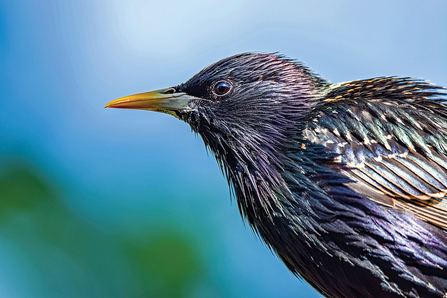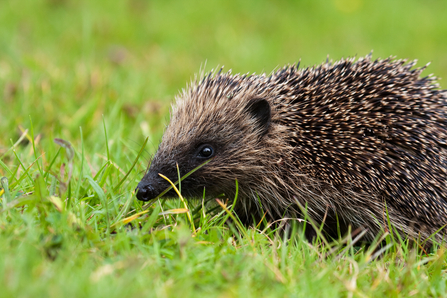March, and the days are truly drawing out as later in the month we reach the spring equinox when day and night are of equal length. It feels like spring is gathering momentum with new ‘firsts’ appearing every day, first butterfly, first bumblebee, first chiffchaff? What a great time to be out in the garden.
March 2021 Wildlife Gardening Enews
Bee flying to dandelion © John Hawkins
Spring news from the garden at Plumgarths.

February: Starling by Alan Beale
- Stunning starlings
- All of our garden birds will be looking at their very best at this time of year as they pair up for the breeding season, before the exhaustive work of parenthood takes its toll! Starlings, sometimes regarded the ‘bully boys’ of the birdfeeders, are looking especially dazzling and it is worth taking time to appreciate the finer points of their brilliant iridescent plumage as it catches the spring sunshine.
- Look closely and you will see there is a subtle difference between the male and female birds at this time of year, both have yellow bills, but the base of the male’s is pale blue and the female’s pale pink. Easy to remember!

Hedgehog © Vaughn Matthews
- Waking hedgehogs
- If you are lucky enough to have hedgehogs in your neighbourhood look out for them emerging from hibernation this month as the weather warms up.
- They emerge extremely hungry and thirsty so it is a good time to provide them with a shallow dish of fresh water and some supplementary food – either a good quality hedgehog food, meaty cat or dog food or some dry cat biscuits.
- If the weather draws you out of hibernation for a spot of garden spring clearing, do spare a thought for any hedgehogs still tucked away in those untidy corners before you set forth with the shears or rake.
- Dandelions welcome
- I confess I haven’t always been a fan of dandelions, but the more I learn about their value to wildlife the more I love them and let them be, especially when growing in the lawn.
- As one of the earliest wildflowers to come into bloom they are a vital food source for emerging insects such as queen bumblebee and early butterflies. They also attract hoverflies whose larvae are a gardener’s ally, feeding on aphids later in the year.
- The leaves and roots feed moth caterpillars with wonderful names, such as the Small fan-footed wave, Flame, Orange Swift and Nutmeg and these caterpillars, in turn, feed the birds further up the food chain.
- Finally, it is always a welcome sight to see goldfinches, house sparrows, bullfinches and even linnets feeding on the seed heads in the lawn.
- Smooth newts
- We don’t have frogs at Plumgarths but we do have Smooth or ‘Common’ newts and after overwintering in log piles, under dead hedges and compost heaps they will soon return to the pond to breed. Being nocturnal, they become active as night time temperatures rise in the spring.
- If you’re not sure whether you have newts in your pond now is a good time to start looking. They can be difficult to spot but if you approach quietly at dawn, dusk or after dark, you may be lucky enough to see the males in bright orange breeding colours performing their courtship display.
- After fertilisation the females lay their eggs individually on leaves before folding them over for protection.

